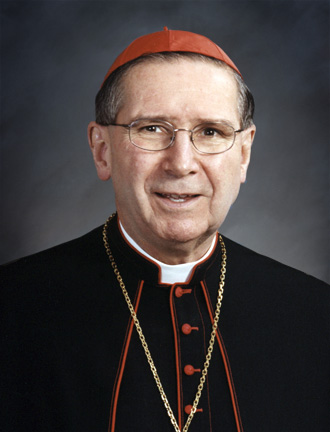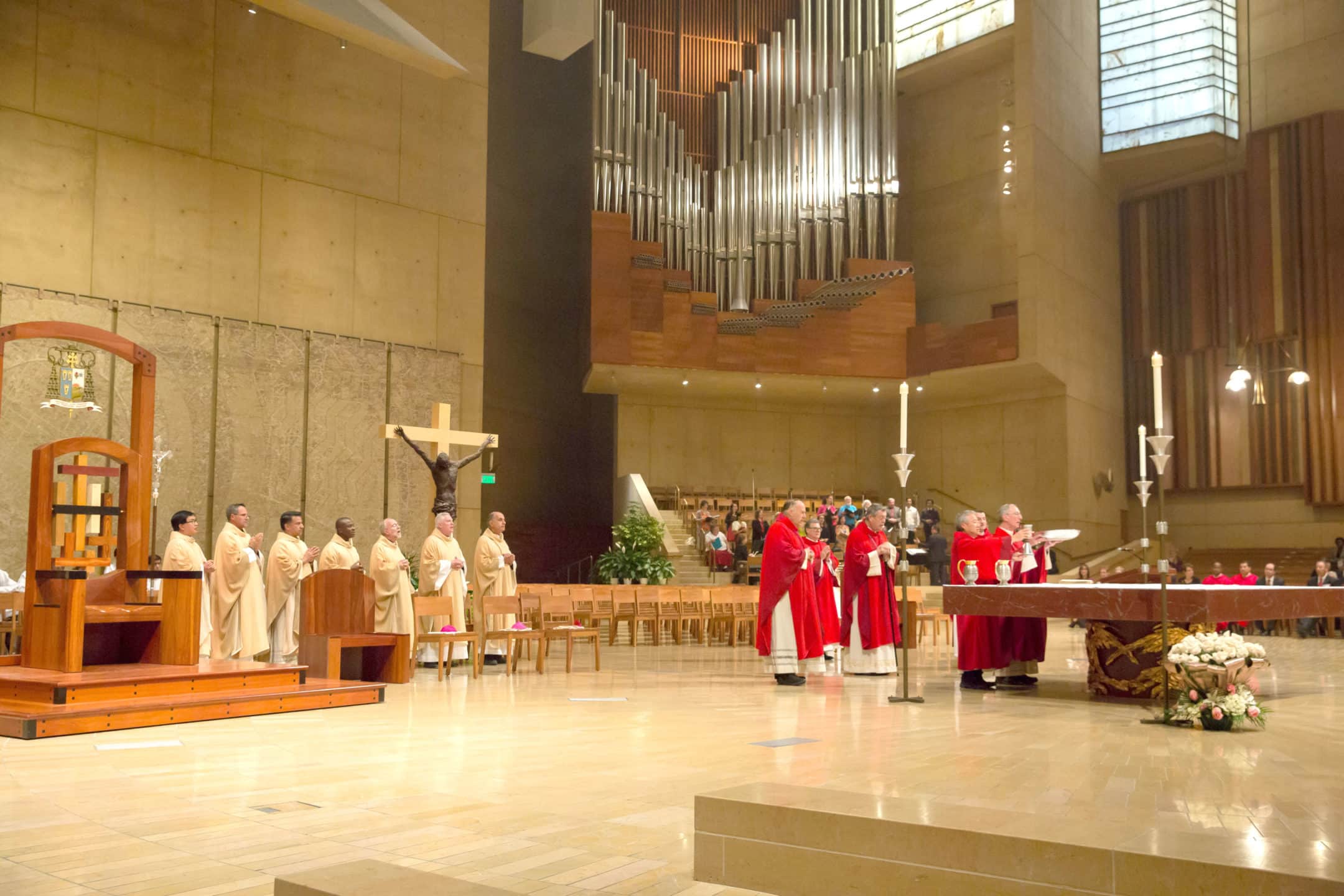Roger Mahony
Archbishop Emeritus
Archbishop Emeritus, Cardinal Mahony is the first native Angeleno to serve as Los Angeles Archbishop, having been born February 27, 1936, in Hollywood. The son of Victor and Loretta (née Baron) Mahony. He has twin brother and an older brother. As a child he was raised in the San Fernando Valley. He attended St. Charles Borromeo school in North Hollywood and at age 14, he entered Los Angeles College, the junior seminary of the Archdiocese of Los Angeles.

Cardinal Mahony was ordained to the priesthood on May 1, 1962, by the Bishop Aloysius Joseph Willinger, Bishop of Monterrey-Fresno. He graduated from The Catholic University of America in 1964 with a master’s degree in social work. He was named monsignor in February 1967. He was appointed Titular Bishop of Tamascani and Auxiliary Bishop of Fresno January 7, 1975. That same year, Cardinal Mahony was appointed the first chair of the California Agricultural Labor Relations Board by Governor Jerry Brown.
In 1986, to better minister to the five million Catholics in the Archdiocese, Cardinal Mahony created the five Pastoral Regions (Our Lady of the Angels, San Pedro, Santa Barbara, San Fernando, San Gabriel). In 1995, he announced plans to build the Cathedral of Our Lady of the Angels to replace the earthquake-damaged former St. Vibiana’s Cathedral. On September 2, 2002 he dedicated the Cathedral.
Cardinal Mahony served on a number of committees of the United States Conference of Catholic Bishops, including Chairman of these Committees: Arbitration and Conciliation, Pro-Life, Domestic Affairs, International Affairs, and Migration and Refugees. With the Holy See, he served as a member of the Pontifical Council for Justice and Peace (1984-1989), the Pontifical Council for the Pastoral Care of Migrants and Itinerants (1986-1991), the Pontifical Council for Social Communications (1898-2010), the Council of Cardinals for the Economic and Administrative Concerns of the Holy See (1991-2010), and the Congregation for Eastern Churches (2008-2011).

As a member of the College of Cardinals, on April 18-19, 2005, Cardinal Mahony participated in the Papal Conclave that was convened following the death of Pope John Paul II on April 2, 2005, that resulted in the election of Pope Benedict XVI.
On February 27, 2011, Cardinal Mahony reached his mandatory retirement age and was succeeded as Archbishop of Los Angeles by Archbishop José H. Gomez.
Following the resignation of Pope Benedict XVI, Cardinal Mahony traveled to Rome, where he was one of 115 cardinal-electors who participated in the Papal Conclave of March 13, 2013 that elected Pope Francis.

Cardinal Roger Mahony’s coat of arms is composed of a shield, with a motto scroll and the external ornaments. The shield is the central and most important feature of the heraldic device.
By ancient tradition, the arms of an archbishop are joined with the arms of his jurisdiction as seen in the impalement on the left side of the shield.
The arms are composed of a blue shield on which are three pairs of gold angel’s wings, each one guarding a golden rose. Each of the roses, which are badges of the Blessed Virgin Mary, is guarded by a pair of angel’s wings to signify El Pueblo de Nuestra Señora de Los Angeles. The colors, blue and gold, are those most usually associated with Our Lady.
The cardinal’s personal arms (right side of the shield), adopted at the time of his election as Auxiliary Bishop of Fresno and used during his tenure as Bishop of Stockton, employ a green field on which are imposed a grab of wheat and a bunch of grapes placed in saltair. Those symbols, arranged in an “X” -like position, represent the Greek letter Chi, the initial of “Christ,” and are used to signify the elements of the Holy Eucharist. Below, a silver basket of bread represents the virtue of Charity. Above are two gold roses which honor Our Lady of Guadalupe to whom His Eminence has great devotion. In the upper portion is a black pan-balance on a gold field which signifies the virtue of Justice, the essence of a reconciliation, the overall theme of the design.
For his motto, Cardinal Mahony uses the phrase “To reconcile God’s people,” a phrase signifying that the mission of bishops, priests, deacons and all of God’s people is that of being in harmony with God’s will.
The device is completed with the external ornaments; a gold metropolitan processional cross, which is placed in back of the shield and which extends above and below the shield, and the cardinalatial hat, or galero, with its fifteen red tassels, in five rows, on either side of the shield.
The “galero,” is the broad-brimmed, fringed hat once worn by Catholic cardinals as a sign of their ecclesial responsibility as advisors to the pope. Traditionally, the galero was hung in the cardinal’s cathedral upon his demise.
Galeros have not been actually worn since the 1870s when the practice was discontinued after the loss of the Papal States. As a sign of “mourning” over the loss of the church’s civil autonomy, the cardinals protested by refusing to wear the galero, say church historians. Today, cardinals still receive a red hat from the pope, but it is a red biretta, not a galero.
On Jan. 15, 1953, Pope Pius XII formally bestowed the galero upon Archbishop McIntyre at his installation to the cardinalate at St. Peter’s Basilica in Rome. Interestingly enough, the red hat conferred on Cardinal McIntyre was both the first and last formally presented to a Californian since the ceremony for a cardinal’s installation was simplified after 1967, according to archdiocesan archivist Msgr. Francis J. Weber in his book, Encyclopedia of California’s Catholic Heritage.
At the time of his installation, McIntryre became the 12th American bishop to receive the galero and the first in the west to become a cardinal. A prayer used for the bestowal explained the responsibility and the martyrdom symbolized in the hat’s bright red color:
“Receive the Red Hat, the particular sign of the cardinalatial office, by which is signified that you must show yourself to be steadfast even to death and the shedding of your blood for the exaltation of the Holy Faith, for peace and tranquility among all Christian people, and for the welfare of the Holy Roman Church….”
After receiving a “red hat,” traditional norms stated that it was to be stored in a safe place in the cardinal’s residence. Upon a cardinal’s demise, the hat was to be placed at the foot of the “catafalque,” (coffin platform) after which it was to be suspended from the ceiling of the cathedral or church to which he was attached as evidence of the spiritual authority exercised by princes of the church.
Two galeros are suspended from the ceiling of the Cathedral of Our Lady of the Angels: those of Cardinals McIntyre and Manning.
Archbishop Emeritus
Executive Assistant to Abp. Emeritus